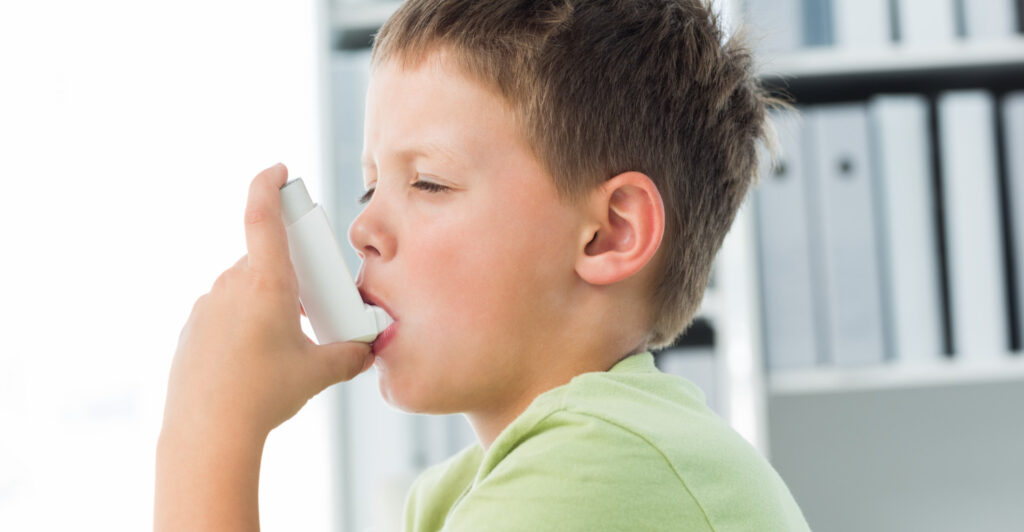Big reveal: I, Dr. Bruce Birk, have asthma.
In fact, I have a classic type of asthma. In my childhood, when I was sick with a virus – or exposed to a cat, or springtime pollen – I would cough and wheeze. My tolerance of exercise was low, so I avoided prolonged sporting activities. Other family members experienced the same asthma symptoms, and some had eczema (inflamed skin), which is a common secondary condition experienced by those with asthma.
Recognizing Common Symptoms of Asthma
Fortunately, my father brought me to our pediatrician, and I was placed on an inhaler intended to reverse the inflammation in my airways. Lo and behold, it worked, and I improved. Miracle? Nope – just basic asthma management of a disease well understood by science for the past 150 years.
Asthma is the most common, reversible airway inflammatory condition experienced by children. It can start at almost any age, but usually shows up in the toddler and early childhood years.
Typical asthma symptoms include:
- Non-cold/flu-related coughing
- Wheezing
- Exercise intolerance (some kids only experience asthma when exercising, especially in colder weather).
- Shortness of breath.
My childhood story is classic and illustrates some common themes we see in our asthma patients:
- A family history of asthma
- Onset of symptoms in childhood
- Worsening of symptoms when exposed to common triggers like a viral infection (Influenza, coronavirus, rhinovirus, parainfluenza virus, etc)
- It is often associated with additional chronic conditions like allergies (especially airborne ones like animal dander/fur and pollen) and eczema.
The Cascade of Inflammation Leading to Asthma
Although my personal asthma triggers are allergens and illness, environmental pollution is another common trigger. In the Northwest, wildfire smoke, especially when settling into our valley, can be particularly irritating to children’s airways, triggering a four-tier cascade of inflammation we call asthma.
Tier 1: Airway Inflammation
First comes “Airway Inflammation.” The lining of the airways becomes swollen and irritated. Airway inflammation is caused by a combination of:
- Immune cells. These are specialized cells that defend the body against invaders. This could be anything from infections, bacteria, or viruses to airborne allergens or particulates.
- Inflammatory mediators. These molecules are also part of the body’s immune defense. Their job is initiating, amplifying, moderating, and eventually stopping the inflammatory response.
- Environmental triggers. These are the many triggers we’ve talked about above that irritate a person’s system, often starting an allergic or asthmatic response depending on a person’s genetics, medical history, and sensitivities.
Tier 2: Airway Hyperresponsiveness
The first tier is followed by “Airway Hyperresponsiveness.” The airways become highly sensitive to stimuli, such as allergens, cold air, or exercise, leading to an exaggerated constriction of the airway muscles.
Tier 3: Airway Obstruction
The next tier in the cascade is “Airway Obstruction.” The combination of airway inflammation, increased mucus production, and muscle constriction causes restricted airflow. This can lead to symptoms like wheezing, coughing, and shortness of breath.
In the midst of an asthma attack, children can feel like they’re breathing through something the size of a stir straw, which can be very scary. This fear and anxiety intensify the sensation. Your PANW pediatrician can help you and your child learn supportive, calming strategies to support ease of airflow during an asthma response until treatment is available.
If your child’s inhaler doesn’t seem to be working correctly and they are having difficulty breathing, never hesitate to call and speak with our experienced triage nurses or schedule an urgent care appointment at PANW to get the support they need ASAP.
Tier 4: Airway Remodeling
Finally, “Airway Remodeling.” In chronic asthma, the airways can undergo structural changes. These changes can make the airways more resistant to treatment and contribute to long-term asthma disease.
What Can Parents & Caregivers Do For Children With Asthma?
So, what do we as parents need to do? Watch for symptoms of asthma and discuss it with your Pediatrician!
Here are the things to watch for:
- A cough that has been occurring for more than 2 weeks (and doesn’t seem to be associated with a common cold or flu).
- A cough that is worse at night, especially with sleep.
- Wheezing.
- Coughing or wheezing with exercise (like running around on a playground).
Check In With Your PANW Pediatrician
There’s no reason to fear asthma. While it isn’t fun, it is treatable and controllable with a little help from your pediatric team at Pediatric Associates of the Northwest. In fact, you can let your child know that some of the most powerful athletes and leaders in the world have experienced asthma – like gold-medal track stars Noah Lyles and Jackie Joyner Kersee, swim champion Tom Dolan, basketball great Dennis Rodman, marathon star Paula Radcliffe, and former presidents Theodore Roosevelt, Bill Clinton, and John F. Kennedy.
There’s almost nothing you can’t do because of asthma. Make an appointment with us here at PANW to establish whether or not your child has asthma, how to minimize its onset, and how to treat it quickly and effectively.





